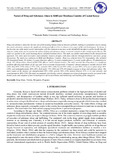Nature of Drug and Substance Abuse in Kilifi and Mombasa Counties of Coastal Kenya
Abstract
Drug and substance abuse has become one of the looming human-induced disasters globally, making it a profound concern among the comity of nations owing to the significant detrimental effects it has in almost every aspect of life and development. In Kenya, it has become one of the major social catastrophes with the commonest and most easily identifiable manifest in public health. Specific objective of the study was to examine the nature of drug and substance abuse in selected counties in the coastal region, Kenya. The study was guided by the social learning theory and functionalism theory. The study was further underpinned by the interpretivism approach. The study used descriptive and evaluative research designs, with data collected through interviews and focus group discussions. The study was conducted in Kilifi and Mombasa Counties. Data was collected from 552 respondents, who included 384 household heads, 20 victims, 2 county education officers, 2 county commissioners, 2 county health officers, 70 administrative chiefs, 102 village elders, 9 head of NACADA officers, and 8 religious leaders. The study revealed that drug abuse is a significant problem affecting individuals of all ages and socio-economic backgrounds. Commonly abused substances include alcohol 99% (383), khat 98% (378), tobacco 97% (376), cannabis 94% (364), heroin 89% (341), cocaine 88% (337), prescription drugs 85% (326), and methamphetamine 80% (307). Both males 75% (289) and 25% (95) females engage in drugs and substance abuse. The main causes of the menace are unemployment 99% (380), poverty 98% (376), mental illnesses 97% (373) and curiosity and experimentation 96% (370). The study recommends strict border control, adequate provision of adequate security personnel at the border posts, and adoption of new technologies to aid in surveillance and monitoring and tracking of the smugglers.
URI
https://ajernet.net/ojs/index.php/ajernet/article/view/101https://doi.org/10.51867/ajernet.4.2.24
http://ir-library.mmust.ac.ke:8080/xmlui/handle/123456789/2285
Collections
- Gold Collection [1026]

